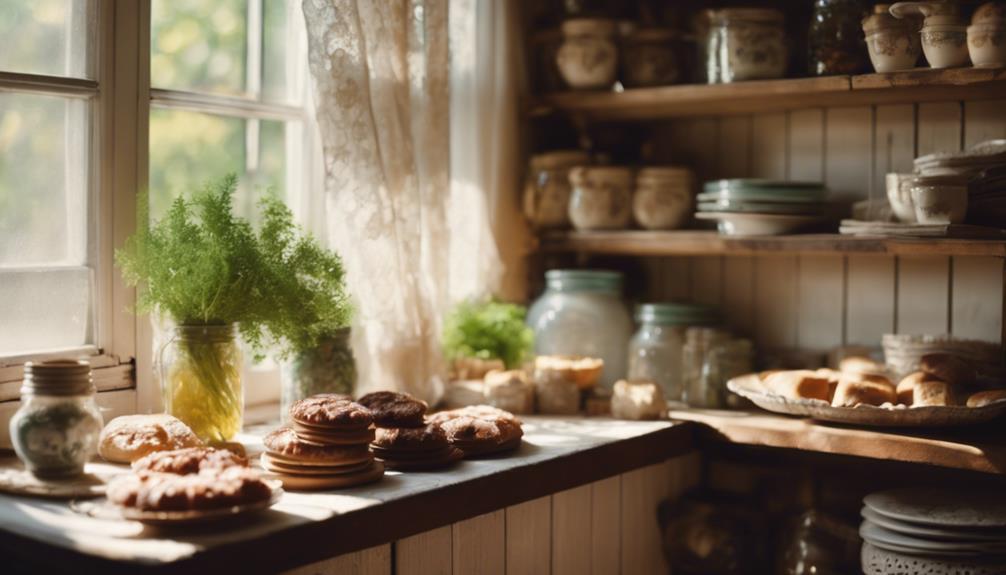Transform your room into a haven embodying cottagecore bliss by embracing natural beauty and vintage charm. Begin with soft, earthy tones and textures such as linen and wool for your textiles. Incorporate live plants and vintage vases to bring life to your space. Rustic wooden furniture and floral patterns will infuse warmth and coziness. Display your culinary creations with open shelving and decorative jars filled with herbs and spices. Mix patterns like gingham and floral prints for a playful touch. With these simple adjustments, you can create a sanctuary that exudes countryside retreat vibes. Explore more ways to elevate your space! You can also infuse elements of cottagecore into intimate wedding concepts with this cozy and charming aesthetic. Picture exchanging vows surrounded by lush greenery and wildflowers, enhanced by vintage lace accents and rustic wooden elements that create an enchanting ambiance. Consider adding personal touches such as hand-painted signs and handmade floral garlands to achieve the idyllic cottagecore wedding aesthetic.
Key Takeaways
- Incorporate vintage furniture like rustic wooden tables and elegant chairs to create a cozy, inviting atmosphere.
- Use soft pastels and earthy tones in your textiles to evoke a warm, natural vibe.
- Add live plants and vintage vases to enhance freshness and bring nature indoors.
- Display colorful dishware and cookbooks on open shelves for a charming, culinary-inspired look.
Understanding Cottagecore Aesthetics

Cottagecore aesthetics blend nostalgia with nature, inviting you to embrace a simpler, more romanticized way of living. This decor style draws inspiration from centuries-old European nobility and countryside retreats, encouraging you to create spaces filled with floral decorations and vintage pieces.
You'll find that rustic touches, like wooden furniture and cozy textiles, foster an inviting atmosphere. By incorporating elements from variants like gardencore and grandmacore, you can personalize your space.
The emphasis on comfort and charm allows you to showcase your personality while connecting to a romantic past. With each carefully chosen item, you'll transform your room into a cozy haven that celebrates the beauty of simplicity and nature's embrace.
Embracing Natural Elements
Incorporating natural elements into your decor not only enhances the aesthetic but also fosters a profound connection to the environment around you.
Start by adding live plants throughout your space; they breathe life and freshness into your room. Choose vintage vases for dried flowers, and don't shy away from using antique hanging planters for a charming touch.
Opt for native plants to bring a local feel, or consider faux options if maintenance is a concern.
Layer textures with natural materials like wood and stone to add depth.
Finally, consider using organic fabrics for cushions and throws, enhancing that cozy, rustic vibe.
Displaying Culinary Inspirations

Displaying culinary inspirations can transform your kitchen into a vibrant and inviting space that sparks creativity in cooking.
Start by showcasing your favorite spices and herbs in decorative jars or vintage containers. Hang a wall-mounted rack for easy access while adding charm.
Utilize open shelving to display colorful dishware, cookbooks, and fresh produce in beautiful bowls. Consider a chalkboard wall for jotting down recipes or grocery lists, adding a touch of whimsy.
Handwritten labels for jars create a personal touch and enhance organization. Finally, incorporate a small herb garden on your windowsill, inviting fresh aromas and flavors into your cooking space.
With these elements, your kitchen will radiate warmth and inspire your culinary adventures.
Mixing Colors and Textures
To create a cohesive cottagecore aesthetic, mix colors and textures that evoke warmth and nostalgia throughout your space. For a cohesive cottagecore aesthetic, consider incorporating soft pastel shades like blush pink, sage green, and sky blue, along with natural textures such as wicker, wood, and floral prints. Add vintage-inspired touches like lace curtains, delicate quilts, and dainty teacups to complete the look. Whether you’re decorating a cozy bedroom or setting up a charming afternoon tea, these elements will help create a timeless and inviting atmosphere, crafting unforgettable event experiences for yourself and your guests.
Start with a neutral base for your larger furniture pieces, then introduce soft pastels and earthy tones through throw pillows, blankets, and curtains.
Layer various materials like linen, cotton, and wool to add depth and comfort. Don't shy away from mixing patterns; floral prints and gingham checks can work beautifully together.
Incorporate natural elements—think wooden accents and woven textures—to further enhance the inviting atmosphere.
You can also add pops of color with vintage-inspired wallpaper or art.
Ultimately, aim for a harmonious blend that reflects your personality while capturing the essence of cottagecore charm.
Vintage Furniture and Decor Choices

What vintage furniture and decor choices can you make to enhance your cottagecore aesthetic?
Start with rustic wooden pieces like farmhouse tables and antique dressers that invite warmth into your space.
Incorporate vintage chairs with elegant curves and soft upholstery to add comfort.
Look for decorative accents, such as Victorian teacups and weathered books, to create a cozy atmosphere.
Wicker baskets can help organize your craft supplies while adding texture.
Don't forget about wall art; choose prints that reflect old-fashioned stories or nature scenes.
Finally, visit thrift stores or antique shops to discover unique finds that resonate with your personal style.
Each piece contributes to a nostalgic and inviting environment, perfect for your cottagecore transformation.
Conclusion
Incorporating cottagecore elements into your room transforms it into a cozy retreat that feels like a scene from a beloved novel. You can bring in vintage furniture, floral patterns, and soft, muted colors to create a timeless and inviting atmosphere. Adding in some homemade crafts, such as hand-knit blankets or embroidered cushions, adds a personal touch to the space. If you’re looking for small wedding ideas, incorporating cottagecore elements into your ceremony and reception can create a romantic and intimate setting that feels warm and welcoming.
By embracing nature, vintage decor, and soft textures, you create a space that's both inviting and nostalgic.
So, grab a cup of chamomile tea and let your creativity flow as you curate your haven.
Remember, it's all about finding joy in the little things—like the smell of fresh herbs or the charm of a well-loved book!








